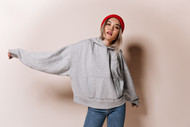How Comfort Clothing Shapes Focus & Burnouts
Oct 1st 2025
You get home. You peel off the “presentable” look, pull on a heavy cotton hoodie that’s been through enough wash cycles to feel like second skin, and suddenly the day exhales.
Why? How?
That shift isn’t just the feel of laziness. It’s your nervous system taking the wheel.
We’ve been taught to think of clothes as public armor, but the truth is simpler: what you wear rewires how you feel and how long you can keep going before your brain gives up.
With burnout as the backdrop of modern life, locked in a loop with distraction, comfort clothing has evolved from at-home luxury to everyday armor for calm focus.
The Psychology of Softness
Clothing is not neutral. Touch matters!
When fabric drapes easily and breathes, when a hoodie’s fleece has softened over time, your body receives a signal: “safe”.
That’s the parasympathetic nervous system in action, the side of you that slows the heart, drops cortisol, and lets focus emerge without fight-or-flight mode.
Psychologists call it enclothed cognition, and according to it, clothes don’t just project an image; they alter the psychological state and performance of the wearer. Stiff, scratchy, restrictive clothes subtly drain attention. Whereas soft, weighty cotton can do the opposite.
Comfort as Attachment
Early life imprints don’t vanish. The blanket you once dragged around was a lesson in safety.
Adults don’t outgrow that wiring; we just swap the blanket for a hoodie. A heavy cotton hoodie that softens and fits better with every wash can feel like a personal security blanket, and when your body feels safe, your brain stops looking for threats and eventually focuses on solving problems.
The trouble begins when comfort breaks down, i.e., seams roughen, cuffs warp, and fabric pills. What was once a refuge turns into a low-level irritation, thus focus frays and burnout creeps in through tiny, overlooked discomforts.
Silicon Valley Casual and Its Double Edge
Tech culture popularized the idea that you can do great things while dressed like you’re between laundry days.
The casual uniform, comprising hoodies and mostly sneakers, does give an untucked ease and liberation from decision fatigue (the dress code of the day). It does work, to a point. Not spending mental energy on outfits is a form of cognitive savings.
However, blurred boundaries are tricky.
If every day feels like the same sweatshirt day, there’s no psychological “clocking in” or “clocking out.” Work time bleeds into rest time. That subtle erosion of ritual feeds the very burnout comfort dressing was meant to prevent.
When Comfort Becomes a Trap

Comfort is a gift until it dulls the edges that help you transition. Living in the same soft uniform day and night can flatten your sense of time.
Focus loves safety, but it also loves a little ceremony. A change of clothes can mark the shift from deep work to deep rest. Lose that ritual and you drift.
It’s also worth noting that “dressing to destress” is easier for some, but comfort is not yet universal.
Many workplaces still police what “professional” looks like. This can be sorted with pieces that stay soft, hold shape, and regulate temperature; however, such luxe comfort comes at a price, so be willing to spend once on formal sweatshirts (collared or buttoned).
Meanwhile, fast fashion offers cheaper versions, but they often degrade just when you’ve grown attached, ultimately killing focus and contributing to environmental waste.
Flow-Friendly Design and Calm-Tech
The sweet spot for focus is flow-friendly clothes, the ones that disappear on your body so your brain can stay on task.
Pure cotton, for instance, breathes and regulates temperature better than synthetic-heavy blends. Heavyweight knits keep their structure, so you don’t feel slumped. And temperature matters more than we admit. Too much warmth makes you foggy; too cold, and your body starts negotiating for attention.
Then there’s the calm-tech like weighted hoodies that gently ground you with seamless interiors for sensory ease, engineered to wick heat or stay cool in long work sprints. All of these qualities whisper “keep going”.
How to Use Comfort Clothing Strategically
Here’s how to get the gain from comfort without falling into the trap:
|
Strategy |
What to Wear |
Purpose / Trigger |
|
Ritualize your clothing shift |
Keep a hoodie just for “work mode”; lounge clothes different |
Gives your brain a visual cue for focus |
|
Mix textures & weights |
Heavy cotton hoodies, mid-weight knits, soft but structured fabrics |
Varying sensory input to keep the brain engaged |
|
Layer thoughtfully |
Hoodie over a crisp tee or light shirt |
Adds form without undoing softness |
|
Limit lounge time |
At lunch or evening, switch into a looser gear |
Resets your internal meter of “off time” |
|
Keep outfit boundaries |
Use clothing & space (desk, room) to set limits |
Prevent work from creeping into rest zones |
Choose with Intention
A focus-friendly wardrobe isn’t about endless shopping; it’s about selecting thoughtful pieces that work well with your body's needs.
Like heavy cotton hoodies that soften over time without losing their shape or breathable layers that regulate your temperature, and seams that feel comfortable.
Include at least one structured piece, like a jacket that signals “now I’m working” when you wear it. The trick lies in choosing well, rotating with intention, and knowing when softness is helping you think and when it’s quietly draining you.
Once you learn to use comfortable clothing wisely, it will help soothe your nervous system, free up your attention, and prevent burnout.

